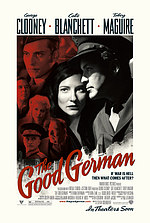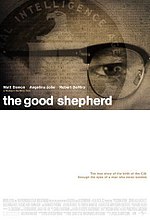
Knight at the Movies Archives
Two ambitious, sprawling costume dramas that could have used a LOT more movie trans fat
Studio executives must be pulling their hair out over the fact that two movies are appearing this week with similar titles. Hard
enough to distract filmgoers during the holidays with the plethora of serious dramas at their disposal – this being the start of awards
season – but to further the confusion, the two pictures in question – The Good Shepherd and The Good German – are both costume
pictures that have something to do with political intrigue. To make it a bit easier The Good Shepherd is the one in color, The Good
German in black and white. Neither, unfortunately, is particularly “good.”
The Good Shepherd is one of those movies that from its weighty subject matter (the history of the CIA set against the backdrop
of “human emotions”) to its top drawer, Oscar winning cast (Matt Damon-Angelina Jolie-Robert DeNiro-William Hurt) screams
“Prestige.” But like other pictures of this ilk – and the list is long – “Prestige” often means “Dullsville.” What we have here (in
almost three hours) is a glacier of a picture, a luxurious iceberg sized movie slowly, slowly floating along. It’s so beautifully and
sumptuously made one could eat off the print but the subject matter is so dense, the characters so overbearing and internalized that
sitting through it without nodding off seems a courageous act in itself. It’s a joyless, bloated epic that makes you scratch your head
in wonder. This is what DeNiro (who directed) spent ten years passionately trying to get made? Really?
Not that the rise of the CIA with their “code words,” dirty tricks and willful nastiness aren’t worth revealing. But let’s face it – this is
one hell of a creepy subject to spend almost three hours with if you’re going to go the Important Picture route. And the tone of the
movie is so somber and mind-numbing, going from one hateful episode to the next, that even interest in the by the book fictional
characters wedged into the real events fades.
The movie begins in April of 1961 when Edward Wilson (Matt Damon), a founding member of the CIA is overseeing the operation to
invade Cuba and displace Castro. But the mission’s failure points to a stoolie within the Organization. Someone squealed to a
prostitute in a cheap hotel room about the forthcoming invasion. A blurry photograph of the room and an illicit tape of this tryst is
all the evidence that Edward has to go on. “There’s a stranger in our house” he’s told by one of his superiors and advised to find
the culprit. Something about this mission causes Edward to look back over a life dedicated to secrets and lies.
We begin with Edward’s initiation into the ultimate WASP male organization, Yale’s ultra secret Skull and Bones club in 1939. This
secret society (members have included both Bush’s, captains of industry, etc.) which values adherence to traditional American values,
discretion and of course money and power was Ground Zero for the CIA. After successfully passing the sexually tinged initiation
rites, Edward proves his loyalty and becomes a welcome addition to the group. He is next tapped by an Army General (DeNiro) to
help start the covert agency the OSS that would later become the CIA.
During this process we see that the well-born Edward is haunted by the suicide of his father but don’t find out much else about him or
his other socially elite friends or family. Apparently, he just never learned to say “No” or “I’ll get back to you” and so when he’s
called into service, he blindly hops to. Without so much as a by your leave, he gives evidence that sends his liberal poetry
professor, Dr. Fredericks (Michael Gambon) packing. Next he quickly falls hard for the dazzling debutante Margaret (Angelina Jolie).
When she becomes pregnant Edward, who has fallen in love with a deaf girl, nevertheless does “the right thing” and weds Margaret.
But quickly he’s called to Europe to help with espionage work behind the scenes at the outset of WWII. Startlingly, his old prof is
also part of the team but when Dr. Fredericks’ taste in gay escorts supersedes his discretion, Edward stands by and does nothing
while the professor is murdered. After that, as the episodes pile up, moving from WWII into the Cold War, Edward seems only to
have loyalty to the job and the other agents (and a more beautiful crop of CIA operatives you’ve never seen – they include Billy
Crudup). Nothing seems to phase him – not the disintegration of his marriage, or the distant relationship with his son. Then,
finally, when the inevitable Sins of the Father get visited on the son Edward finally stirs from his rock hard formation – sorta.
By that point however, DeNiro’s lavish, glossy epic, so top heavy with the weight of its subject and so tedious, has slowly, slowly,
slowly sunk beneath the waves of its good intentions.
Director Stephen Soderbergh has gone in another direction altogether with The Good German but with similarly dismaying
results. With his regular star George Clooney at the helm Soderbergh attempts to pull off the same trick that Todd Haynes so
brilliantly used for Far From Heaven. This is to shoot a new movie in the artificial style of an old one but without the old morality code
that kept the lid on the frankness. And what movie fan wouldn’t love to see a modern day film noir, set in postwar Germany ala The
Third Man or Billy Wilder’s Foreign Affair? It’s a truly tantalizing idea.
But though Soderbergh has a marvelous cast (in addition to Clooney, there’s Cate Blanchett standing in for Dietrich as a scheming
German prostitute and Tobey Maguire as a repulsive opportunist), he doesn’t seem to know what to do with them and the screenplay
is strictly from hunger. Like the Coen brothers’ overrated The Man Who Was Never There proved, getting the look and feel of an old
film noir isn’t so hard to do – it’s having a good story, dialogue and characters that are absolute must haves.
But none of those essential elements are here – from Clooney’s distracted journalist to Blanchett’s breathless fallen woman to
Maguire’s dopey turn as a baddie. Soderbergh has managed to recreate something from Hollywood’s past alright, but unfortunately
it’s less than what he was aiming for. They used to call them B Pictures and that’s exactly what The Good German is.
enough to distract filmgoers during the holidays with the plethora of serious dramas at their disposal – this being the start of awards
season – but to further the confusion, the two pictures in question – The Good Shepherd and The Good German – are both costume
pictures that have something to do with political intrigue. To make it a bit easier The Good Shepherd is the one in color, The Good
German in black and white. Neither, unfortunately, is particularly “good.”
The Good Shepherd is one of those movies that from its weighty subject matter (the history of the CIA set against the backdrop
of “human emotions”) to its top drawer, Oscar winning cast (Matt Damon-Angelina Jolie-Robert DeNiro-William Hurt) screams
“Prestige.” But like other pictures of this ilk – and the list is long – “Prestige” often means “Dullsville.” What we have here (in
almost three hours) is a glacier of a picture, a luxurious iceberg sized movie slowly, slowly floating along. It’s so beautifully and
sumptuously made one could eat off the print but the subject matter is so dense, the characters so overbearing and internalized that
sitting through it without nodding off seems a courageous act in itself. It’s a joyless, bloated epic that makes you scratch your head
in wonder. This is what DeNiro (who directed) spent ten years passionately trying to get made? Really?
Not that the rise of the CIA with their “code words,” dirty tricks and willful nastiness aren’t worth revealing. But let’s face it – this is
one hell of a creepy subject to spend almost three hours with if you’re going to go the Important Picture route. And the tone of the
movie is so somber and mind-numbing, going from one hateful episode to the next, that even interest in the by the book fictional
characters wedged into the real events fades.
The movie begins in April of 1961 when Edward Wilson (Matt Damon), a founding member of the CIA is overseeing the operation to
invade Cuba and displace Castro. But the mission’s failure points to a stoolie within the Organization. Someone squealed to a
prostitute in a cheap hotel room about the forthcoming invasion. A blurry photograph of the room and an illicit tape of this tryst is
all the evidence that Edward has to go on. “There’s a stranger in our house” he’s told by one of his superiors and advised to find
the culprit. Something about this mission causes Edward to look back over a life dedicated to secrets and lies.
We begin with Edward’s initiation into the ultimate WASP male organization, Yale’s ultra secret Skull and Bones club in 1939. This
secret society (members have included both Bush’s, captains of industry, etc.) which values adherence to traditional American values,
discretion and of course money and power was Ground Zero for the CIA. After successfully passing the sexually tinged initiation
rites, Edward proves his loyalty and becomes a welcome addition to the group. He is next tapped by an Army General (DeNiro) to
help start the covert agency the OSS that would later become the CIA.
During this process we see that the well-born Edward is haunted by the suicide of his father but don’t find out much else about him or
his other socially elite friends or family. Apparently, he just never learned to say “No” or “I’ll get back to you” and so when he’s
called into service, he blindly hops to. Without so much as a by your leave, he gives evidence that sends his liberal poetry
professor, Dr. Fredericks (Michael Gambon) packing. Next he quickly falls hard for the dazzling debutante Margaret (Angelina Jolie).
When she becomes pregnant Edward, who has fallen in love with a deaf girl, nevertheless does “the right thing” and weds Margaret.
But quickly he’s called to Europe to help with espionage work behind the scenes at the outset of WWII. Startlingly, his old prof is
also part of the team but when Dr. Fredericks’ taste in gay escorts supersedes his discretion, Edward stands by and does nothing
while the professor is murdered. After that, as the episodes pile up, moving from WWII into the Cold War, Edward seems only to
have loyalty to the job and the other agents (and a more beautiful crop of CIA operatives you’ve never seen – they include Billy
Crudup). Nothing seems to phase him – not the disintegration of his marriage, or the distant relationship with his son. Then,
finally, when the inevitable Sins of the Father get visited on the son Edward finally stirs from his rock hard formation – sorta.
By that point however, DeNiro’s lavish, glossy epic, so top heavy with the weight of its subject and so tedious, has slowly, slowly,
slowly sunk beneath the waves of its good intentions.
Director Stephen Soderbergh has gone in another direction altogether with The Good German but with similarly dismaying
results. With his regular star George Clooney at the helm Soderbergh attempts to pull off the same trick that Todd Haynes so
brilliantly used for Far From Heaven. This is to shoot a new movie in the artificial style of an old one but without the old morality code
that kept the lid on the frankness. And what movie fan wouldn’t love to see a modern day film noir, set in postwar Germany ala The
Third Man or Billy Wilder’s Foreign Affair? It’s a truly tantalizing idea.
But though Soderbergh has a marvelous cast (in addition to Clooney, there’s Cate Blanchett standing in for Dietrich as a scheming
German prostitute and Tobey Maguire as a repulsive opportunist), he doesn’t seem to know what to do with them and the screenplay
is strictly from hunger. Like the Coen brothers’ overrated The Man Who Was Never There proved, getting the look and feel of an old
film noir isn’t so hard to do – it’s having a good story, dialogue and characters that are absolute must haves.
But none of those essential elements are here – from Clooney’s distracted journalist to Blanchett’s breathless fallen woman to
Maguire’s dopey turn as a baddie. Soderbergh has managed to recreate something from Hollywood’s past alright, but unfortunately
it’s less than what he was aiming for. They used to call them B Pictures and that’s exactly what The Good German is.
Not So Good:
The Good Shepherd-The Good German
12-20-06 Windy City Times Knight at the Movies Column
By Richard Knight, Jr.
The Good Shepherd-The Good German
12-20-06 Windy City Times Knight at the Movies Column
By Richard Knight, Jr.


